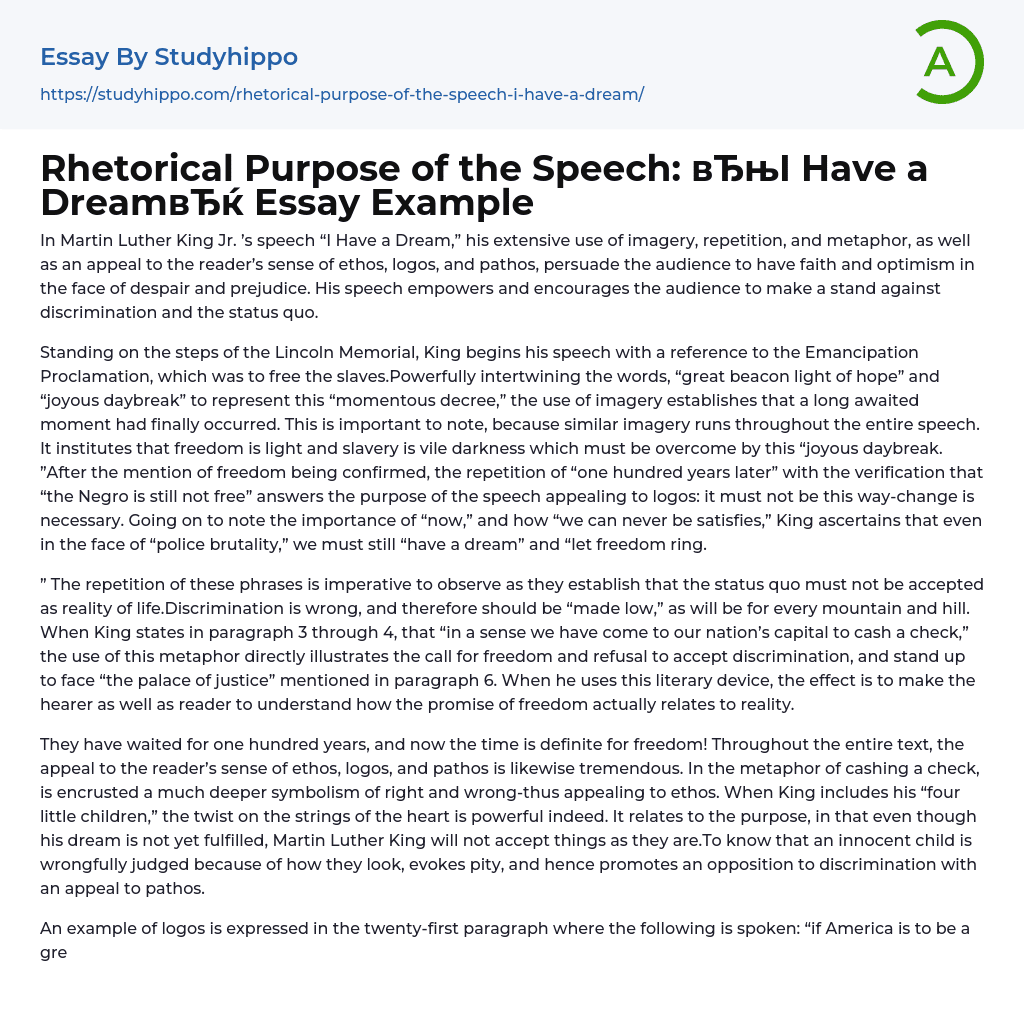

Rhetorical Purpose of the Speech: “I Have a Dream” Essay Example
In Martin Luther King Jr. ’s speech “I Have a Dream,” his extensive use of imagery, repetition, and metaphor, as well as an appeal to the reader’s sense of ethos, logos, and pathos, persuade the audience to have faith and optimism in the face of despair and prejudice. His speech empowers and encourages the audience to make a stand against discrimination and the status quo.
Standing on the steps of the Lincoln Memorial, King begins his speech with a reference to the Emancipation Proclamation, which was to free the slaves.Powerfully intertwining the words, “great beacon light of hope” and “joyous daybreak” to represent this “momentous decree,” the use of imagery establishes that a long awaited moment had finally occurred. This is important to note, because similar imagery runs throughout the entire speech. It institutes
...that freedom is light and slavery is vile darkness which must be overcome by this “joyous daybreak. ”After the mention of freedom being confirmed, the repetition of “one hundred years later” with the verification that “the Negro is still not free” answers the purpose of the speech appealing to logos: it must not be this way-change is necessary. Going on to note the importance of “now,” and how “we can never be satisfies,” King ascertains that even in the face of “police brutality,” we must still “have a dream” and “let freedom ring.
” The repetition of these phrases is imperative to observe as they establish that the status quo must not be accepted as reality of life.Discrimination is wrong, and therefore should be “made low,” as will be for every mountain and hill. When King states in paragraph 3 throug
4, that “in a sense we have come to our nation’s capital to cash a check,” the use of this metaphor directly illustrates the call for freedom and refusal to accept discrimination, and stand up to face “the palace of justice” mentioned in paragraph 6. When he uses this literary device, the effect is to make the hearer as well as reader to understand how the promise of freedom actually relates to reality.
They have waited for one hundred years, and now the time is definite for freedom! Throughout the entire text, the appeal to the reader’s sense of ethos, logos, and pathos is likewise tremendous. In the metaphor of cashing a check, is encrusted a much deeper symbolism of right and wrong-thus appealing to ethos. When King includes his “four little children,” the twist on the strings of the heart is powerful indeed. It relates to the purpose, in that even though his dream is not yet fulfilled, Martin Luther King will not accept things as they are.To know that an innocent child is wrongfully judged because of how they look, evokes pity, and hence promotes an opposition to discrimination with an appeal to pathos.
An example of logos is expressed in the twenty-first paragraph where the following is spoken: “if America is to be a great nation this must become true,” referring to the preceding text. In other words, the only way that America is going to progress, is if all are given true equality and freedom. This is the perfect example of the use of reason and logic.It is an effective appeal to the reader’s sense of logos. With the conclusion, it may
be noted that the use of these stylistic as well as persuasive, and widely used literary devices effectively support the purpose of the essay. The audience is able to grasp visible illustrations of why freedom is to be prioritized over the darkness of discrimination-which should not be accepted as the status quo, and stand up to face that opposition with “faith” and perseverance.
- My Dream essays
- My Dream Job essays
- Book Summary essays
- Metaphor essays
- Reader essays
- Rhyme essays
- Literary devices essays
- Villain essays
- Books essays
- Genre essays
- Literary Criticism essays
- Writer essays
- Protagonist essays
- Simile essays
- Poem essays
- Book Report essays
- Book Review essays
- Greek Mythology essays
- Plot essays
- Tragic Hero essays
- Coming of Age essays
- Play essays
- Rhetoric essays
- Rhetorical Question essays
- Translation essays
- Understanding essays
- Reason essays
- Character essays
- Letter essays
- American Literature essays
- Literature Review essays
- Utopia essays
- Poetry Analysis essays
- Dante's Inferno essays
- Between The World and Me essays
- Incidents in The Life of a Slave Girl essays
- Flowers for Algernon essays
- Myth essays
- Everyday Use essays
- Boo Radley essays
- Genesis essays
- Richard iii essays
- Alice in Wonderland essays
- On the road essays
- Ozymandias essays
- The Nightingale essays
- Holden Caulfield essays
- Animal Farm essays
- 1984 essays
- A Hanging essays



